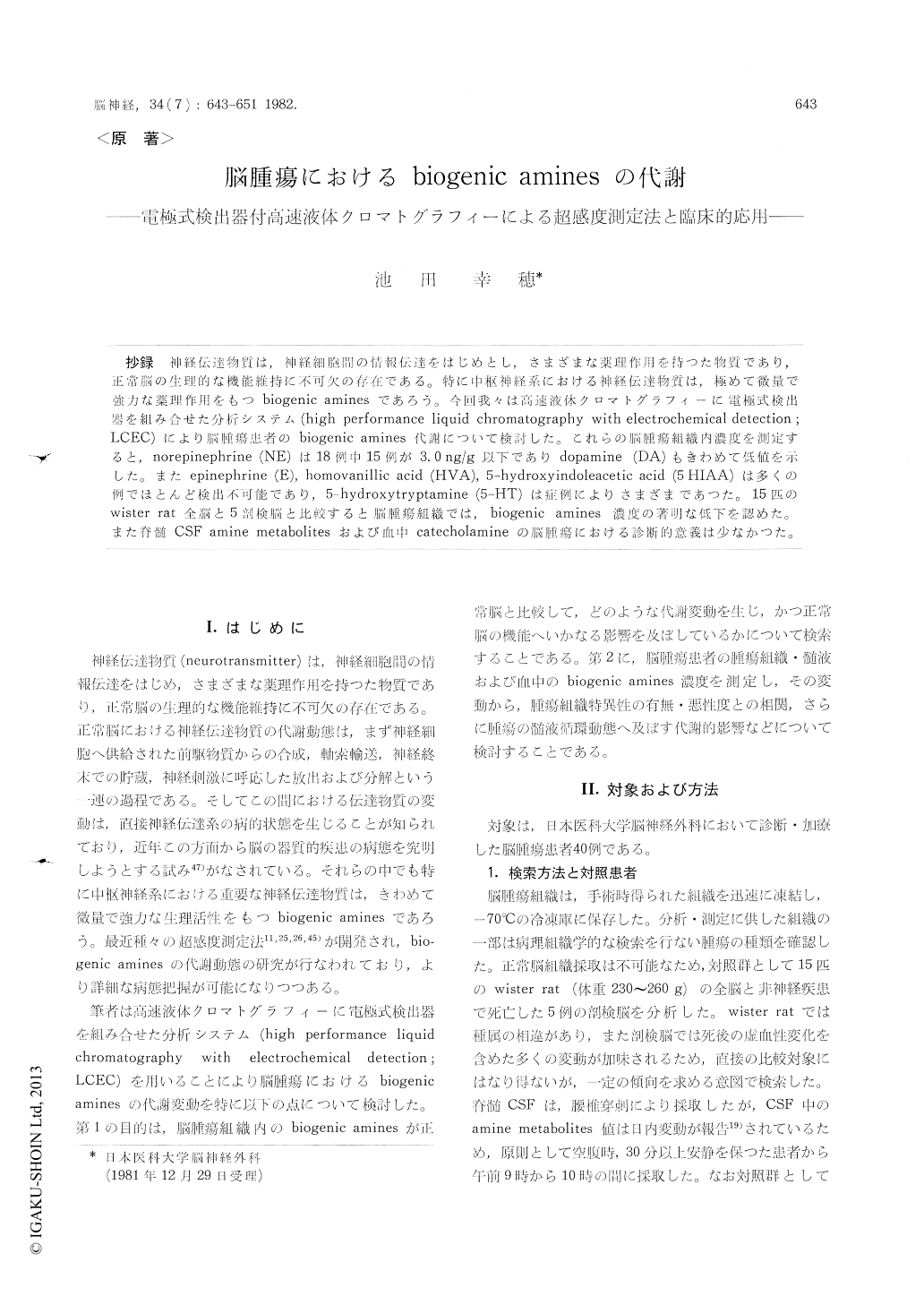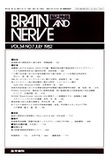Japanese
English
- 有料閲覧
- Abstract 文献概要
- 1ページ目 Look Inside
抄録 神経伝達物質は,神経細胞間の情報伝達をはじめとし,さまざまな薬理作用を持つた物質であり,正常脳の生理的な機能維持に不可欠の存在である。特に中枢神経系における神経伝達物質は,極めて微量で強力な薬理作用をもつbiogenic aminesであろう。今回我々は高速液体クロマトグラフィーに電極式検出器を組み合せた分析システム(high performance liquid chromatography with electrochemical detection;LCEC)により脳腫瘍患者のbiogenic amines代謝について検討した。これらの脳腫瘍組織内濃度を測定すると,norepinephrine (NE)は18例中15例が3.0ng/g以下でありdopamine (DA)もきわめて低値を示した。またepinephrine (E),homovanillic acid (HVA),5—hydroxyindoleacetic acid (5HIAA)は多くの例でほとんど検出不可能であり,5—hydroxytryptamine (5—HT)は症例によりさまざまであった。15匹のwister rat全脳と5剖検脳と比較すると脳腫瘍組織では,biogenic amines濃度の著明な低下を認めた。また脊髄CSF amine metabolitesおよび血中catecholamineの脳腫瘍における診断的意義は少なかつた。
High performance liquid chromatography systems equipped with electrochemical detection (LCEC) are particularly well suited for the separation and the measurement of the concentration of norepine-phrine (NE), epinephrine (E), dopamine (DA), 5- hydroxytryptamine (5-HT), and their metabolites ; homovanillic acid (HVA), 5-hydroxyindolacetic acid (5-HIAA) and 3-methyoxy-4-hydroxyphenylethy-leneglycol (MHPG) in brain tissues and cerebro-spinal fluids (CSF).
Brain tumors are thought to affect and change the neurotransmitter function, the metabolisms in tumor, the surrounding cerebral tissues and the constituents of CSF. A study of monoamines and their metabolites in tumor tissues and CSF has become an interesting approach to the problem of clarifying the role of biogenic amines in patients with brain tumors.
The present study was undertaken to determine whether the measurement of the concentrations of monoamines and their metabolites in tumor tissues, CSF and blood could be used as a diagnostic tool in patients with brain tumors, and also whether their concentrations were related to histological types and/or the degree of malignancy. Samples from eighteen intracranial tumors removed at opera-tions were studied. Control and comparative studies were carried out in fifteen wister rat whole brains (body weight: 230-260 gr) and five autopsy cases. The concentrations in tumor tissues were measured by LCEC. Separation was achieved on ODS columnsing a mobile phase of citrate (3Na)-citrate buffer (pH 4.5) for the measurement of monoamines, or citrate (Na)-citrate buffer (pH 4.5) containing 12% acetic acid, 10% methanol and 1 % tetrahydrofuran for the measurement of their metabolites. NE levels were under 3ng/g in most cases. DA levels were not detected in more than half of cases. HVA levels were detected only in three metastatic brain tumors and one neuroblastoma. E and 5HIAA were not measured in most cases. 5-HT levels varied from 0ng/g to 166. 4ung/g. From these data, it appears that no evident relationship was present between the histological type of tumor and the concentrations of biogenic amines in brain tumor tissues. Low amine levels found in tumor tissues would suggest that in the tumor, i.e., physiologically a nonfunctioned mass, there were changes in themetabolism of biogenic amines which presumably act as neurotransmitter in normal human brains and normal rat brains.
The concentrations of amine metabolites in lum-bar CSF were measured in twelve patients with sellar and parasellar tumors. The correlation analysis revealed no significant relationship between levels of pituitary hormones in serum and 5HIAA & HVA levels in CSF. Their concentrations in lumbar CSF were concluded to have no diagnostic significance, especially in patients with sellar and parasellar tumors. In this biochemical analysis of biogenic amines, we still do not have enough cases to summarize the definite conclusion and many factors must be considered in the interpretation of these results of clinical study.

Copyright © 1982, Igaku-Shoin Ltd. All rights reserved.


